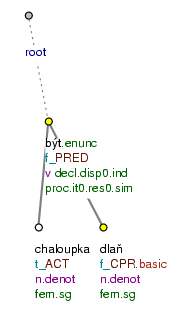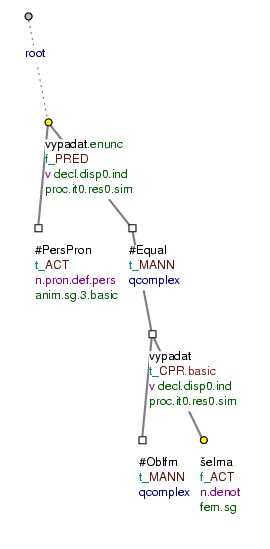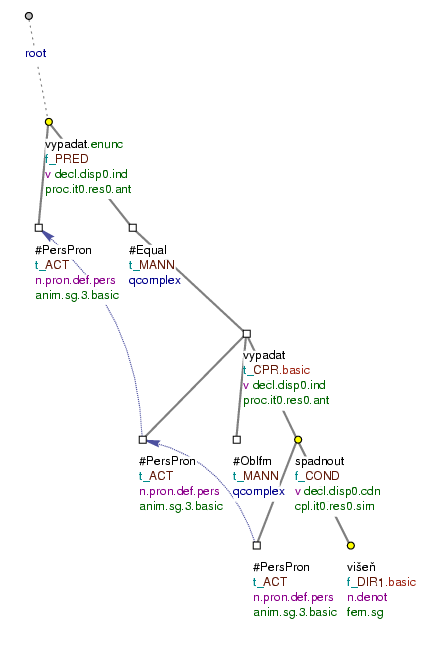The conjunction "jako" (=like) is used for comparison based on similarity or identity.
In most cases, we think of this type of construction as involving comparison of two events (or states), based on a property/feature, degree of identity/difference/similarity (see Section 4.1.1, "Comparing two events by means of the conjunction "jako"").
Direct comparison. Only two types of construction are recognised that are treated as direct comparison of two entities (i.e. not referring to any degree). These are:
-
Comparison of the type: "nominative is like nominative".
This construction contains the verb být and there is no nominal part (of the predicate) after být; instead the comparison is expressed directly by means of the conjunction "jako" and a noun in the nominative.
The node representing the noun in the nominative has the
CPRfunctor and depends on the verb být (the verb být has the role of the substitute "být" - see Section 2.1.2, "Substitute "být"").Examples:
Chaloupka je jako dlaň.
CPR(=lit. Cottage is like palm) Fig. 8.51Moučník je jako báseň.
CPR(=lit. Dessert is like poem)Dívka je jako obrázek.
CPR(=lit. Girl is like picture) -
Comparison of the type: "noun like nominative".
In this construction, two entities are compared directly. The noun following "jako" is always in the nominative.
The node representing the noun in the nominative has the
CPRfunctor and depends on the node for the preceding noun.Examples:
Vstoupil do chaloupky jako dlaň.
CPR(=lit. (He) entered in cottage like palm.NOM) Fig. 8.52Kousl do moučníku jako báseň.
CPR(=(He) bit into dessert like poem.NOM)Viděl dívku jako obrázek.
CPR(=(He) saw girl like picture.NOM)NB! Constructions like Vstoupil do chaloupky jako na dlani. (=lit. (He) entered in cottage like on palm) are analyzed according to rules in Section 4.1.1, "Comparing two events by means of the conjunction "jako"".
Figure 8.52. Direct comparison
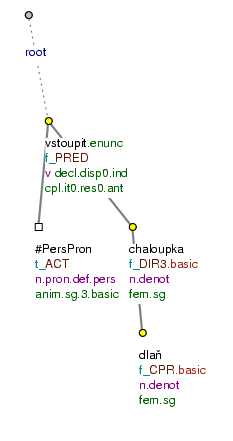
Vstoupil do chaloupky jako dlaň. (=lit. (He) entered into cottage like palm)
When comparing two events (or states) by means of the conjunction "jako" (=like/as), the node for the governing verb of the dependent comparative clause has the CPR functor and depends on the node for the expression referring to the degree of identity/difference/similarity in the governing clause.
Expression referring to the degree of identity/difference/similarity The expression referring to the degree of identity/difference/similarity with the event in the dependent clause is often an adverb (e.g.: tak (=so, this), stejně (in_the_same_way), rychle (=fast)), or adjective (e.g.: podobný (=similar), stejný (=same), rychlý (=fast)) in positive. This node can have different functors depending on its position in the sentence:
-
if it represents an adverb, its functor is usually
MANN.For example:
Udělal to rychle.
MANN, jako to udělal.CPRTonda. (=He did it fast as Tonda did it) Fig. 8.53Rozdělení dramaturgie je stejně.
MANNdůležité jako je.CPRdůležité soutěžení. (=Division of dramaturgy is as (=lit. in_the_same_way) important as competing is important) -
in constructions with the copula "být" it has the
PATfunctor (especially if it represents an adjective).For example:
Je zdravý.
PAT, jako je.CPRzdravá ryba. (=He is fit as fish is fit) Fig. 8.57 -
the expression referring to the degree of identity/difference/similarity can also modify a noun and have the
RSTRfunctor.For example:
Poslanec je člověk stejný.
RSTRjako je.CPRkaždý jiný. (=A deputy is human just like (lit. same like) everybody else is) Fig. 8.61Vydělal stejně.
RSTRpeněz jako vydělal.CPRv zahraničí. (=He earned the same money as he did abroad) Fig. 8.62
Ellipsis of the expression referring to the degree of identity/difference/similarity. The expression referring to the degree of identity/difference/similarity does not have to be present in the surface form of the sentence. Such a construction is interpreted as a construction in which the expression referring to the degree of identity/difference/similarity with the event in the dependent clause is present at the tectogrammatical level (and omitted in the surface form). Then, a new node with the t-lemma #Equal and a corresponding functor is added to the subtree for the governing clause. The effective root node of the dependent clause is dependent on this newly established node, then. Cf.:
-
Udělal to {
#Equal.MANN} , jako to udělal.CPRTonda. (=He did it like Tonda did it)= He did it the same way as Tonda (did it).
In place of the absent expression referring to the degree of identity/difference/similarity, a new node with the t-lemma substitute
#Equaland theMANNfunctor is added. The effective root node of the dependent clause is dependent on this newly established node. Cf. Fig. 8.55. -
Poslanec je člověk {
#Equal.RSTR} , jako je.CPRkaždý jiný. (=A deputy is human like everybody else is)= A deputy is human in the same way everybody else is (human).
In place of the absent expression referring to the type of identity/difference/similarity, a new node with the t-lemma substitute
#Equaland theRSTRfunctor is added. The effective root node of the dependent clause is dependent on this newly established node. Cf. Fig. 8.61.
Ellipsis of the governing verb of the dependent clause. If the governing verb of the dependent clause is not present in the surface form of the sentence, a new node with the CPR functor is inserted into the dependent clause in compliance with the rules in Section 12.1, "Ellipsis of the governing element" (usually, it is copied from the governing clause).
Examples of constructions with ellipsis of the governing verb in the dependent clause:
Udělal to rychle jako { udělat.CPR} Tonda. (=He did it (as) fast as Tonda) Fig. 8.54
Mluví zbrkle {#Equal.MANN} jako { mluvit.CPR} ty. (=He talks rashly just like you)
Je zdravý jako { být.CPR} { zdravý.PAT} ryba. (=He is fit as fish) Fig. 8.58
Rozdělení dramaturgie je stejně důležité jako{ být.CPR} { důležitý.PAT} soutěžení. (=Division of dramaturgy is as important as competing)
Examples of constructions with ellipsis of the governing verb of the dependent clause as well as the expression referring to the degree of identity/difference/similarity:
Udělal to {#Equal.MANN} jako { udělat.CPR} Tonda. (=He did it like Tonda) Fig. 8.55
Vstupoval do bytu {#Equal.MANN} jako{ vstupovat.CPR} do jámy lvové. (=He was entering the room like a lion's den)
NB! In exceptional cases, when the ellipsis analysis would be really unnatural, no node for the governing verb is added into the dependent clause; the construction is considered to be an idiom. For example:
Vše běží jako na drátkách. [ jako_na_drátkách.DPHR] (=Everything is running smoothly; lit. everything runs like on wires)
Node with the t-lemma substitute #Oblfm. When analyzing comparative constructions (with comparison of two events), the following t-lemma substitutes are also used: #Oblfm and #Some. A node with the #Oblfm t-lemma is used in these constructions in cases when an obligatory adjunct in the dependent clause is not expressed; it is impossible to copy the relevant modification from the governing clause, due to semantic reasons (there, the obligatory adjunct is expressed by adverbs like stejně (=in_the_same_way), podobně (=similarly), jinak (=other_way)). This rule interacts with the rule regarding representing non-expressed obligatory modifications by means of adding new nodes with t-lemma substitutes into the structure (see Section 12.2.1.3, "Ellipsis of an obligatory free modification (t-lemma substitutes #Oblfm and #Rcp)"). Cf.:
-
Vypadá jako šelma. (=She looks like a beast of prey)
= She looks just like a beast of prey looks.
In place of the absent expression referring to the degree of identity/difference/similarity, a new node with the t-lemma substitute
#Equaland theMANNfunctor is added. This node is in the position of the obligatory manner adjunct at the same time. For the same position in the dependent clause, a new node with the#Oblfmt-lemma has to be added. Cf. Fig. 8.64.Another example:
Jednala s ním {
#Equal.MANN} jako se jedná.CPRse sluhou {#Oblfm.MANN} . (=She treated him like people treat servants)
Node with the t-lemma substitute #Some. A node with the t-lemma #Some is added into the subtree for the dependent clause in place of the non-expressed nominal part of the verbonominal predicate if it is impossible to copy the relevant node from the governing clause (due to semantic reasons; i.e. in cases when this nominal part is represented by adjectives like stejný (=same), podobný (=similar), jiný (=different)). Cf.:
-
Je stejný jako já. (=He is just like me)
= He is the same as I am
The dependent clause modifies the expression stejný. In the position of the effective root node of the dependent clause (its governing verb), there is a node copied from the governing clause. Due to semantic reasons, it is however impossible to copy the nominal part of the predicate as well; therefore, a new node with the t-lemma
#Someand thePATfunctor is inserted in the relevant position, then. Cf. Fig. 8.59.More examples:
Požadavky jsou podobné jako { být.
CPR} {#Some.PAT} u České spořitelny . (=The requirements are the same as with CS) Fig. 8.60Nemoci důvěřovat je {
#Equal.PAT} jako { být.CPR} {#Some.PAT} pobývat u nepřítele. (=Not to be able to trust is like staying with the enemy) Fig. 8.63
For more on copying of multi-word predicates, see Section 12.1.1.1, "Textual ellipsis of the governing verb".
Comparison expressed by a deverbal adjective or noun. Comparative constructions in which the governing clause (expressing the comparison) is nominalized, i.e. represented by a deverbal adjective or noun, are analyzed similarly (to the cases described above). For example:
muž vypadající jako popisovaný lupič (=lit. man looking like described robber) (= the man who looks just like the described robber)
muž chovající se jako dítě (=lit. man behaving like child) (= the man who behaves in the same way children do)
Ellipsis of the governing clause. Similarly, also complex cases involving ellipsis of the governing clause are analyzed. For example:
Vypadá, jak by spadl z višně. (=lit. (He) looks like (he) fell from wild_cherry_tree) (= He looks the same he would look would he fall from a wild cherry tree.) Fig. 8.65
Dělala kotrmelce, jako když byla malá. (=lit. (She) made somersaults like when (she) was small) (=She made somersaults the same way she did when she was small.)
For the rules, see Section 12.1.3, "Ellipsis of the governing clause".
Figure 8.53. Comparison by means of the conjunction "jako"
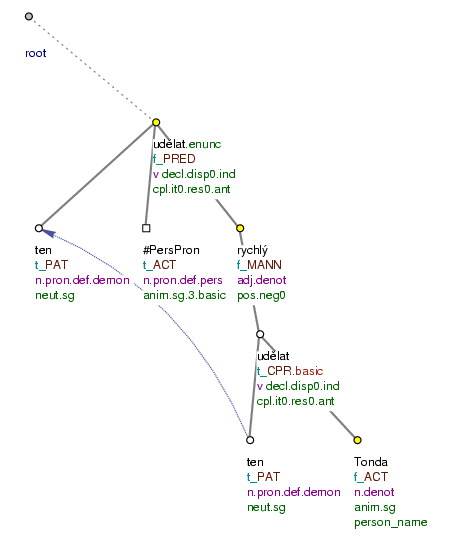
Udělal to rychle, jako to udělal Tonda. (=lit. (He) did it fast, like it did Tonda)
Figure 8.54. Comparison by means of the conjunction "jako"
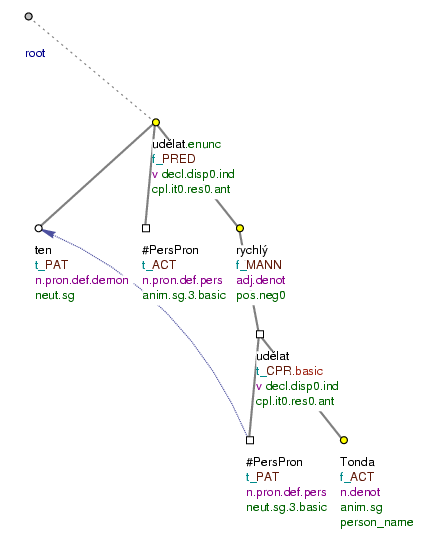
Udělal to rychle jako Tonda. (=lit. (He) did it fast like Tonda)
Figure 8.55. Comparison by means of the conjunction "jako"
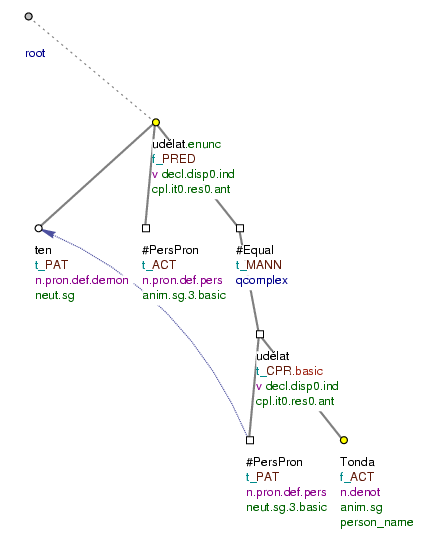
Udělal to jako Tonda. (=lit. (He) did it like Tonda)
Figure 8.56. Comparison by means of the conjunction "jako"
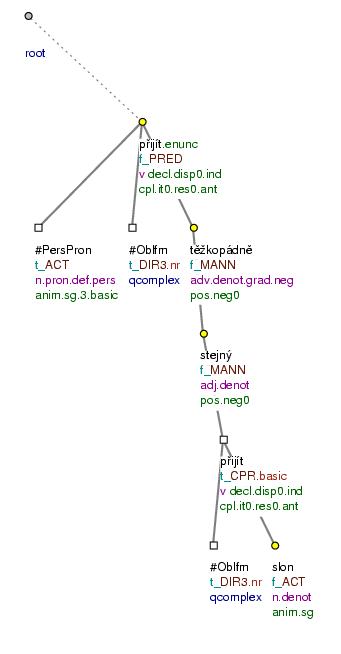
Přišel stejně těžkopádně jako slon. (=lit. (He) came equally clumsily as elephant)
Figure 8.57. Comparison by means of the conjunction "jako"
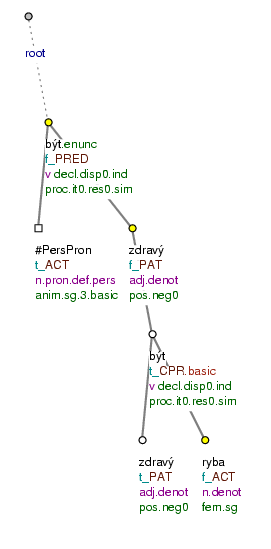
Je zdravý, jako je zdravá ryba. (=lit. (He) is healthy, like is healthy fish)
Figure 8.58. Comparison by means of the conjunction "jako"
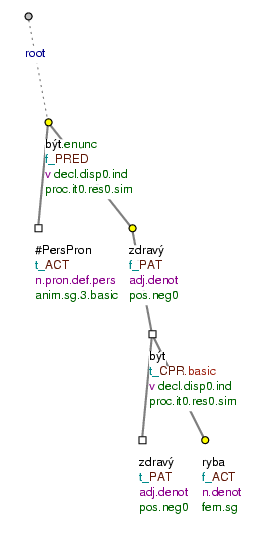
Je zdravý jako ryba. (=lit. (He) is healthy like fish)
Figure 8.59. Comparison by means of the conjunction "jako"
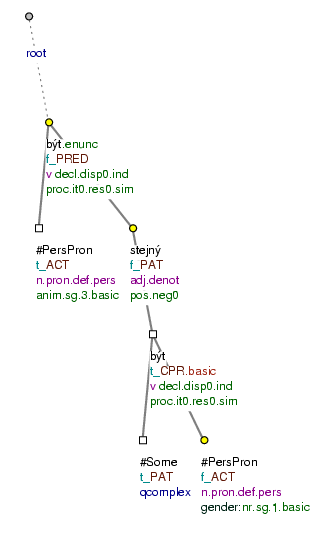
Je stejný jako já. (=lit. (He) is same as I)
Figure 8.60. Comparison by means of the conjunction "jako"
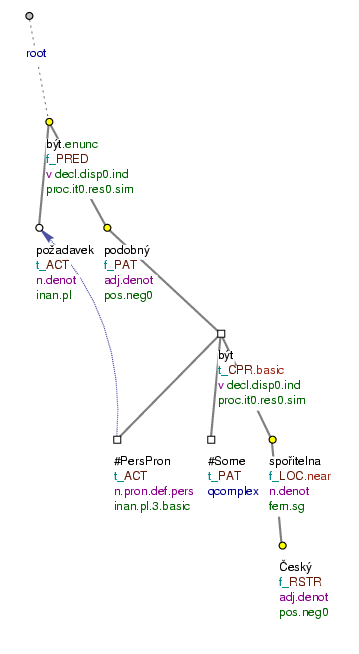
Požadavky jsou podobné jako u České spořitelny. (=lit. Requirements are similar as with Česká spořitelna)
Figure 8.61. Comparison by means of the conjunction "jako"
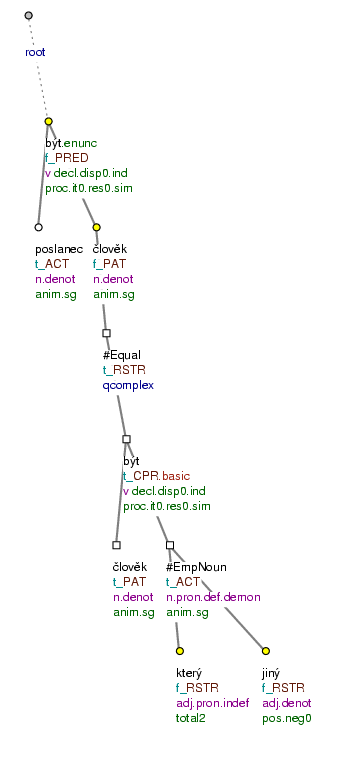
Poslanec je člověk jako každý jiný. (=lit. Deputy is man like everybody else)
Figure 8.62. Comparison by means of the conjunction "jako"
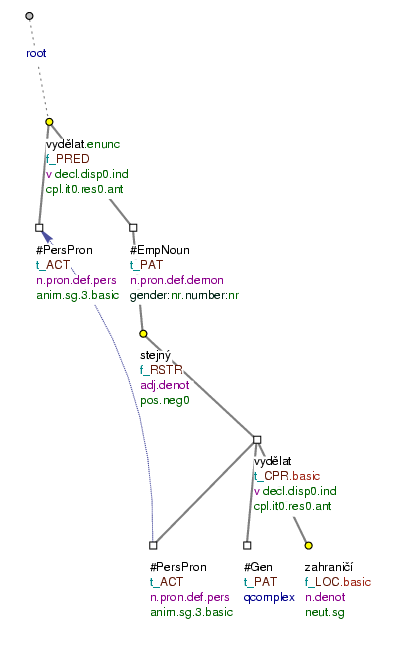
Vydělal stejně jako v zahraničí. (=lit. (He) earned the_same as in abroad)
Figure 8.63. Comparison by means of the conjunction "jako"
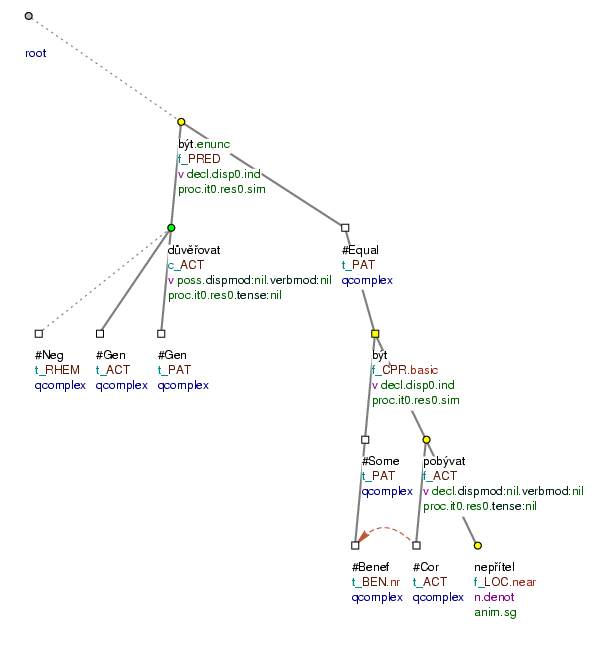
Nemoci důvěřovat je jako pobývat u nepřítele. (=lit. Not_to_be_able to_trust is like to_be with enemy)
